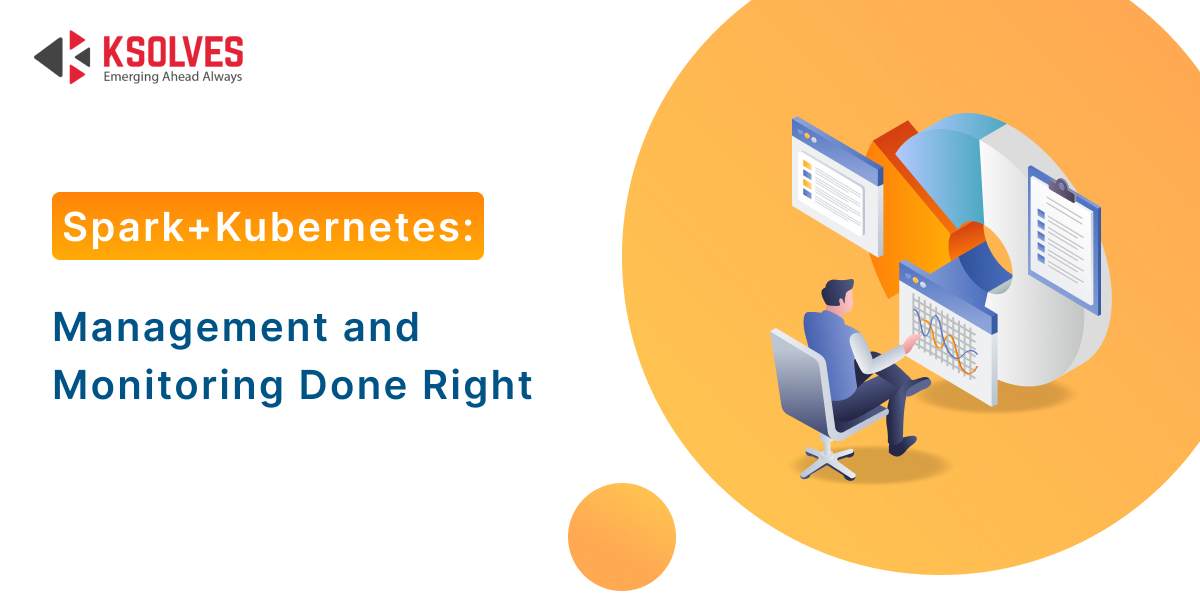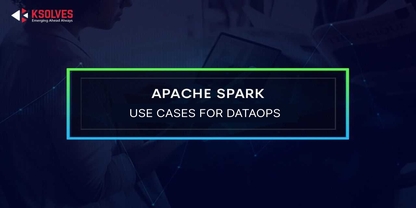Managing and Monitor Apache Spark On Kubernetes
Spark
5 MIN READ
March 1, 2024
![]()

When it comes to management and monitoring of distributed data processing workloads there is only one winner in the game named Apache Spark on Kubernetes. This integration leverages the scalability and flexibility of Kubernetes orchestration for spark applications.
Organizations can effortlessly allocate resources, achieve high availability and scale their analytics workloads dynamically. Manage Apache Spark On Kubernetes is quite popular as it is backed by a plethora of advantages.
This blog enlightens the fact that how this approach simplifies deployment and enhances resource utilization, making it an attractive solution for modern data processing needs.
Let’s start the dive by exploring the capabilities of Spark on Kubernetes:
- Dynamic Resource Allocation:
It can efficiently allocate and manage computing resources based on workload demands, ensuring optimal resource utilization.
High Availability: Running Spark on Kubernetes benefits from the high availability features provided by the Kubernetes platform, enhancing overall reliability.
- Isolation and Multi-Tenancy:
Kubernetes facilitates isolation between Spark applications and supports multi-tenancy. It allows organizations to run multiple Spark workloads concurrently.
- Elastic Scaling:
It empowers you to dynamically scale resources up or down based on the workload, ensuring that Spark applications can adapt to changing processing requirements.
- Integration with Kubernetes Ecosystem:
Spark seamlessly integrates with other Kubernetes-native tools and services, enabling a cohesive ecosystem for containerized data processing.
These are just a handful of capabilities of running spark on Kubernetes.
Basic Process of Running Sparks on Kubernetes
Submitting Spark Applications:
- To submit a Spark application on Kubernetes, you will have to use the `spark-submit` command.
- You have to start with the basic command structure:
spark-submit \
–class <main_class> \
–master k8s://<k8s_master_url> \
–deploy-mode cluster \
–executor-memory <executor_memory> \
–executor-cores <executor_cores> \
–num-executors <num_executors> \
<your_spark_application.jar> [application_args]
“`
Concepts in Kubernetes
- Spark Driver:
The driver is the main program that runs the `main` function of your Spark application and creates a SparkContext. On Kubernetes, the driver runs in a Kubernetes pod.
- Executors:
Executors are processes launched for Spark tasks. They run on worker nodes and perform data processing tasks. In the context of Kubernetes, each executor runs in its pod.
- Pods:
A pod is the smallest deployable unit in Kubernetes. It represents a single instance of a running process, and Spark leverages pods to execute driver and executor components.
Key Configuration Options:
- Driver Memory:
Set the memory allocated to the Spark driver. Use `–driver-memory <memory>` in the `spark-submit` command.
- Executor Cores:
Define the number of cores each executor should use. Utilize `–executor-cores <cores>` in the `spark-submit` command.
- Other Configurations:
Additional configurations, such as setting the number of executors (`–num-executors`) and executor memory (`–executor-memory`), are crucial for resource optimization.
You have to adapt the placeholders (`<…>`) in the command examples with your specific application details. This approach allows Spark to efficiently utilize Kubernetes resources, ensuring optimal performance and scalability for your data processing tasks.
Manage Apache Spark On Kubernetes: An Overview
Submitted:
- Users submit Spark applications using the ‘spark-submit’ command, specifying parameters and the application’s main class or script.
- Application specifications are sent to the Kubernetes cluster.
Running:
- Kubernetes schedules pods (containers) to run Spark driver and executor tasks.
- Spark application processes data using allocated resources.
Completed:
- Upon successful execution, the Spark application completes its tasks.
- Pods are terminated, freeing up resources.
Failed:
- In case of failure, logs and status information help diagnose issues.
Tools and Techniques for Managing Spark Applications:
Kubernetes Commands:
- Use ‘kubectl get pods’ to view Spark application pods.
- Check logs using ‘kubectl logs <pod-name>’ for debugging.
- Delete pods with ‘kubectl delete pod <pod-name>’ if necessary.
Spark Operator:
- The Spark Operator is a Kubernetes-native controller managing Spark applications.
- It automates the deployment, scaling, and management of Spark applications.
- Custom Resource Definitions (CRDs) define SparkApplications, allowing easy management.
Advanced Features:
Dynamic Allocation:
- You have to dynamically adjusts the number of executors based on workload.
- Enhances resource utilization and improves performance.
Failure Handling:
- Automatically recovers from executor or node failures.
- Maintains fault tolerance for Spark applications.
Key Configuration Options:
Driver Memory:
- Set with ‘–driver-memory’ in ‘spark-submit’.
- Determines memory allocation for the Spark driver.
Executor Cores:
- Specified with ‘–executor-cores’ in ‘spark-submit’.
- Controls the number of CPU cores assigned to each executor.
If you are looking forward to managing Apache Spark on Kubernetes you need to be hands-on with the lifecycle of Spark application. It involves having a better understanding of utilizing Kubernetes commands, incorporating the Spark Operator etc.
Why Should You Monitor Apache Spark On Kubernetes?
Monitoring Apache Sparks is just like having a pair of vigilant eyes on your Spark applications. It helps in identifying bottlenecks and optimizing resource usage. It also helps in quickly diagnosing and resolving to avoid potential bottlenecks.
How to Monitor Apache Spark On Kubernetes
Key Metrics to Monitor
Spark Driver and Executor Resource Utilization
- CPU Usage: Monitor the CPU consumption of Spark driver and executor pods.
- Memory Usage: Keep track of memory utilization to avoid potential bottlenecks.
Job Progress:
- Stages and Tasks: Check the progress of Spark jobs through completed stages and tasks.
- Completion Time: Monitor the overall time taken for job completion.
Application Logs and Events:
- Examine logs for errors, warnings, or other relevant information.
- Track events to understand the flow and performance of the Spark application.
Tools and Techniques for Monitoring
Kubernetes Dashboard:
- What it Does: It provides a graphical interface to visualize Kubernetes resources and pod health.
- How to Use: you have to execute ‘kubectl proxy’ and access the dashboard.
Spark UI:
- What it Does: You have to offer detailed insights into Spark application execution. It provides a comprehensive insight into Spark application execution, including task progress, resource utilization, and DAG visualization. It helps in effective performance monitoring and optimization.
- How to Access: You have to find the Spark UI link in the Spark application logs
Prometheus and Grafana:
What it Does: You have to enable the creation of custom dashboards for in-depth monitoring.
How to Set Up: Deploy Prometheus and Grafana, configure Prometheus to scrape Spark metrics, and create visualizations in Grafana.
You also need to understand that Spark monitoring is not just about fixing problems; it’s about staying proactive and ensuring your Spark applications are running optimally.
Some Best Practices for Spark Performance on Kubernetes
Best Practices for Spark Performance on Kubernetes:
Resource Allocation Strategies:
- You have to utilize dynamic resource allocation to adapt to changing workloads efficiently.
- Next, balance the allocation of memory and CPU resources based on the nature of Spark tasks.
Pod Scheduling and Node Affinity:
- You can leverage Kubernetes affinity rules to ensure Spark driver and executor pods run on nodes with adequate resources.
- Optimize pod scheduling for locality, minimizing data transfer across nodes.
Configuration Tuning:
- You have to fine-tune Spark configurations such as ‘spark.executor.instances’, ‘spark.executor.memory’, and ‘spark.driver.memory’ based on workload requirements.
- Adjust the parallelism settings to optimize task execution.
Advanced Topics for Further Exploration
Spot Instances for Cost Optimization:
- Explore the use of Kubernetes spot instances or preemptible VMs for Spark workloads to optimize costs.
- Implement strategies for handling potential interruptions, such as checkpointing and task resiliency.
Security Considerations for Spark on Kubernetes:
- The first thing here is to implement security measures for data protection in transit and at rest.
- Explore role-based access control (RBAC) in Kubernetes to restrict access to Spark resources.
- Integrate with tools like Apache Ranger or Kubernetes-native solutions for enhanced security.
Exploration Tools</b
For further exploration and implementation of these best practices and advanced topics, consider utilizing the following tools and frameworks:
Apache Spark Monitoring:
- Leverage built-in metrics of Spark and Spark UI for detailed monitoring.
- Integrate with Prometheus and Grafana for a more comprehensive monitoring solution.
Kubernetes Apache Spark Operator:
- Automate deployment and management of Spark applications using the Spark Operator for Kubernetes.
- Leverage custom resource definitions (CRDs) for seamless interaction with Kubernetes.
Adopting these best practices and exploring advanced topics not only optimizes performance but also ensures the reliability and cost-effectiveness of your Spark applications running on Kubernetes.
Conclusion
So, orchestrating Apache Spark on Kubernetes empowers organizations with dynamic scalability resource utilization. The Spark operator streamlines the deployment and robust monitoring through Kubernetes tools ensures optimal performance.
To run everything in the desired flow you need a hands-on experience with the technology. Ksolves is one of the best Apache Spark consulting companies aiding businesses with tailored solutions and resolving pain points.
![]()







AUTHOR
Spark
Atul Khanduri, a seasoned Associate Technical Head at Ksolves India Ltd., has 12+ years of expertise in Big Data, Data Engineering, and DevOps. Skilled in Java, Python, Kubernetes, and cloud platforms (AWS, Azure, GCP), he specializes in scalable data solutions and enterprise architectures.
Share with